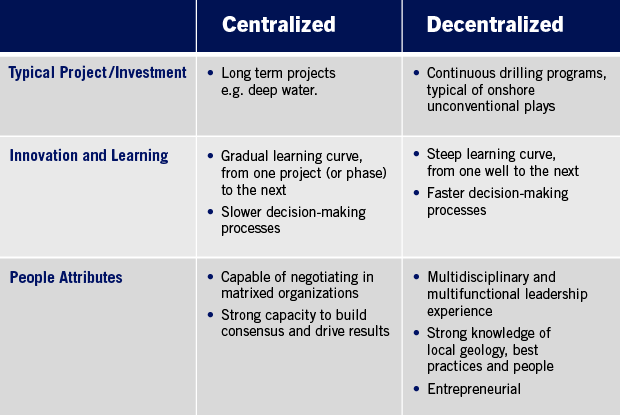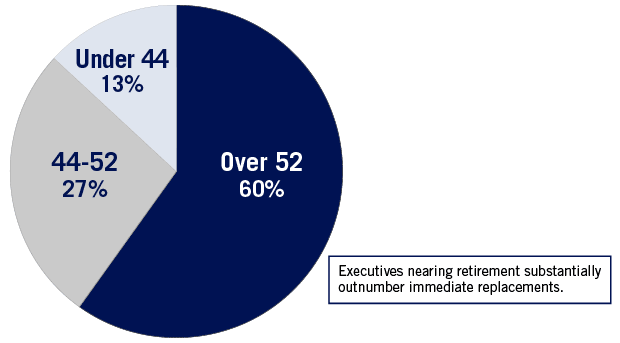
Finding Leaders
Right Talent Vital For America’s Energy Dynamics
By Stephen Morse and Mauro Gimenez
As the global oil market continues to seek a balance between supply and demand, industry analysts are increasingly in agreement that swing oil production capacity has shifted to North America, at least in the near term. Executives in the U.S. oil and gas industry fully understand that unconventional resources are redrawing the energy landscape, and comprehend what today’s changing market dynamics mean from an operating and economic angle. However, many remain uncertain about these dynamics’ implications for talent development and optimization.
The decentralized operating structure evident among several U.S. onshore companies has helped create a new breed of leaders ready to embrace future challenges in the oil and gas industry. This distinct class of oil industry leader has a fundamentally different approach to management and a set of competencies that are key to success in unconventional oil and gas. Seeding this new type of a leader and adopting a business model that is appropriate for unconventional plays may turn out to be a necessity if the industry is to continue providing the attractive returns it historically has given investors.
Centralized versus Decentralized Organizational Models
Many companies have evolved a centralized operating model to manage the technical and economic risks associated with multibillion dollar megaprojects such as deepwater offshore developments. Such projects often take more than a decade to develop, from exploration to first production.
Because they are often involved in such projects, centralization has become the prevailing organizational approach among global integrated oil companies. In these institutions, functions such as research and development aim for major step changes. In case of a downturn, megaprojects in operation will likely keep producing, while those in the planning or development stage may be canceled or postponed as long as the commodity price environment remains unfavorable.
A decentralized model has in some cases helped to make decision making faster at the regional and asset levels. Companies that use this model excel in situations that require them to repeat the same task over and over, for they can process information and make decisions quickly enough to improve their techniques from one well to the next. Such companies are able to climb the steep cost and production learning curves required to achieve exceptional returns and attract investment in unconventional plays.
With less technical risk from an operational point of view and a greater need to evolve to meet market demand, decentralized organizations can at times delegate major decisions on capital allocation and project management to regional heads and asset leaders. These leaders often have considerable influence over when, where and how wells get drilled. Their multidisciplinary and multifunctional experience, as well as their knowledge of local geology, best practices and people, has played a key role in the U.S. shale success story.
Talent Implications of the Organizational Models
Long-term growth in the oil and gas industry has been tied to not only exploration success, but also to technological improvements that help make ongoing developments more profitable, much faster. Digital capabilities will help companies solve more intricate optimization problems in a fraction of the time previously required. Given the competitive advantage this speed accords, organizations must identify operational leaders who have the analytical acumen and insight to adopt digital innovations into the best strategic actions. Companies must also find the right functional leaders to support their business leaders.
On that note, some degree of centralized decision making at the supply chain level that drives higher buyer bargaining power and other synergies can help the regional leaders extract more value from their assets. However, this centralization must not compromise decision-making speed. For organizations to capitalize on key learnings and opportunities, the ease and speed at which teams, equipment and capital can be transferred will be key.
For long-term upstream growth to happen with market forces balancing oil supply and demand, energy companies must find executives who can evolve. These executives need to be highly-motivated people who have the competitive drive to thrive on challenge and constantly seek new improvement opportunities, but that is not enough. They must also have:
- The broad view required to lead diverse and disparate teams and make multidisciplinary decisions;
- The mental agility and analytical skills necessary to learn from limited experience and make decisions quickly; and
- The strong execution skills needed to turn their plans into a reality.
Large integrated oil company executives approach big one-off risks and derisk them with thorough technical analysis and lengthy structured decision stage gates in order to minimize the chance of mistakes. In such cases, learning is optimized by taking a more conservative approach to risk from one project (or project phase) to the next. In contrast, many companies with a decentralized organizational model take small, educated risks one after the other, and incorporate incremental improvements quickly, from one well to the next.
In a centralized model, capital allocation happens during the annual or biannual planning cycles. In a decentralized model, capital allocation is revisited more frequently, so regional leaders regularly compete for capital and resources from the company. This internal competition is one of the engines driving the technical creativity we have seen in recent years in the onshore U.S. industry.
In a way, each regional head is the leader of his or her own smaller company, and corporate is the ultimate parent company supplying funding. To rise to the top of their organization, managers need to be entrepreneurial and have a keen competitive edge.
The differences between centralized and decentralized companies, as well as the characteristics leaders must demonstrate to promote the success of each organization type, are summarized in Table 1.
A New Approach
Some of the major players are stepping out of their traditional organization structures to test “hybrid” organizational models. Under these models, decisions with extremely high stakes continue to be made through the traditional series of gates. However, less risky projects with more rapid turnaround times are being delegated to regional heads with almost as much flexibility as those associated with decentralized models.
Some of these companies have had the courage to recognize that their top executives may lack the right DNA to lead an unconventional business competitively. Knowing that the best solutions to manage their unconventional business may be outside their executive ranks and their current operating paradigms, these companies have begun to look for or develop new talent. If they find the right people and the hybrid models prove successful, the benefits could be tremendous, for the same models can be applied in other parts of the world.
In the meantime, U.S. shale regional heads and asset leaders working for companies that operate under a form of the decentralized model will continue to remain attractive targets to private equity firms. These firms recognize that such leaders have the entrepreneurial spirit and the right DNA to find, develop and market opportunities that can deliver strong returns in a reasonable timeframe.
It is clear that over the next twelve to eighteen months, the industry will be in flux. During this volatile term, companies should assess their board and leadership teams, as well as their business model. As we have seen in other industry cycles, downturns are often followed by leadership renewal, business model re-evaluation, and consolidation that fuel an inevitable growth upcycle. The current industry condition presents an opportunity for companies to align themselves with leaders who have the right characteristics and skills to be successful in the recovery.
Finding the Right Leaders
So how do companies find and attract leaders with the right DNA to help the organization succeed? Firstly, it is important to have well defined talent metrics, key performance indicators and competency models in place to identify and develop the future leaders. In addition, companies should leverage tools such as Culture Analyst™ that help assess candidate fit to the current and/or desired company culture.
In the long term, the solution may be investing in young employees who lack the experience of a traditional leadership candidate but have the drive and characteristics to become great leaders. This is particularly true today, for the decade-long hiring freeze that began during the recession of 1982 has left the industry with fewer professionals who are naturally preparing to take the reins. Indeed, as Figure 1 shows, there are nearly twice as many energy executives nearing retirement as there are “next generation” executives who provide the foundation for succession. Firms that do not immediately address this problem risk quickly falling behind their rivals.
It is more critical now than ever to align leadership competencies to the specific organizational structure of a company. Understanding how current industry trends are impacting culture based on the organizational structure in place will help companies make the right hiring decisions and provide better development paths for their executives.

Stephen Morse leads the global oil and gas practice for leadership analysis and search firm Russell Reynolds Associates. Based in Houston, he specializes in serving clients in the oil and gas, power and clean technology industries, and has extensive experience identifying chief executive officers, chief operating officers, and human capital leaders for leading organizations. Morse counsels clients ranging from global integrated oil and gas companies to pre-commercial startups, many of which involve private equity investors. He is a member of the firm's CEO and board services practice.

Mauro Gimenez is a managing director in Russell Reynolds Associates’ oil and gas practice. Based in Houston, Gimenez specializes in serving clients in the upstream, midstream and oil field services industries. He has experience conducting board, C-suite and senior vice president-level searches for both public and privately held companies.
For other great articles about exploration, drilling, completions and production, subscribe to The American Oil & Gas Reporter and bookmark www.aogr.com.















